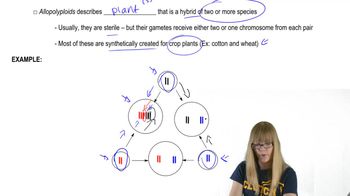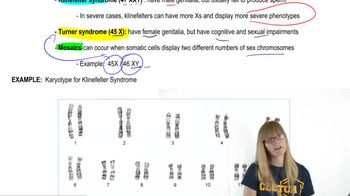A normal female is discovered with 45 chromosomes, one of which exhibits a Robertsonian translocation containing most of chromosomes 15 and 21. Discuss the possible outcomes in her offspring when her husband contains a normal karyotype.
Table of contents
- 1. Introduction to Genetics51m
- 2. Mendel's Laws of Inheritance3h 37m
- 3. Extensions to Mendelian Inheritance2h 41m
- 4. Genetic Mapping and Linkage2h 28m
- 5. Genetics of Bacteria and Viruses1h 21m
- 6. Chromosomal Variation1h 48m
- 7. DNA and Chromosome Structure56m
- 8. DNA Replication1h 10m
- 9. Mitosis and Meiosis1h 34m
- 10. Transcription1h 0m
- 11. Translation58m
- 12. Gene Regulation in Prokaryotes1h 19m
- 13. Gene Regulation in Eukaryotes44m
- 14. Genetic Control of Development44m
- 15. Genomes and Genomics1h 50m
- 16. Transposable Elements47m
- 17. Mutation, Repair, and Recombination1h 6m
- 18. Molecular Genetic Tools19m
- 19. Cancer Genetics29m
- 20. Quantitative Genetics1h 26m
- 21. Population Genetics50m
- 22. Evolutionary Genetics29m
6. Chromosomal Variation
Chromosomal Mutations: Aneuploidy
Problem 31a
Textbook Question
For the following crosses, determine as accurately as possible the genotypes of each parent, the parent in whom nondisjunction occurs, and whether nondisjunction takes place in the first or second meiotic division. Both color blindness and hemophilia, a blood-clotting disorder, are X-linked recessive traits. In each case, assume the parents have normal karyotypes.
A man and a woman who each has the wild-type phenotype have a son with Klinefelter syndrome (XXY) who has hemophilia.
 Verified step by step guidance
Verified step by step guidance1
Step 1: Understand the genetic basis of the traits and syndrome. Color blindness and hemophilia are X-linked recessive traits, meaning they are carried on the X chromosome and require two copies of the recessive allele in females (XX) or one copy in males (XY) to express the phenotype. Klinefelter syndrome (XXY) results from nondisjunction, where an individual has an extra X chromosome.
Step 2: Analyze the phenotypes of the parents. Both the man and the woman have wild-type phenotypes, meaning they do not express hemophilia. This suggests that the woman may be a carrier of the hemophilia allele (X^H X^h), while the man has a normal X chromosome (X^H Y).
Step 3: Determine the genotype of the son. The son has Klinefelter syndrome (XXY) and hemophilia. This means he must have inherited two X chromosomes (one from each parent) and one Y chromosome from his father. The X chromosome carrying the hemophilia allele (X^h) must have come from the mother.
Step 4: Identify the parent in whom nondisjunction occurred. Since the son has two X chromosomes, nondisjunction must have occurred in the mother during meiosis. This resulted in an egg with two X chromosomes (X^H X^h) instead of one.
Step 5: Determine the stage of nondisjunction. If the two X chromosomes in the egg are different (X^H and X^h), nondisjunction occurred during meiosis I, when homologous chromosomes fail to separate. If the two X chromosomes are identical, nondisjunction occurred during meiosis II, when sister chromatids fail to separate.
 Verified video answer for a similar problem:
Verified video answer for a similar problem:This video solution was recommended by our tutors as helpful for the problem above
Video duration:
5mPlay a video:
Was this helpful?
Key Concepts
Here are the essential concepts you must grasp in order to answer the question correctly.
X-linked Inheritance
X-linked inheritance refers to the pattern of inheritance for genes located on the X chromosome. In this case, traits such as color blindness and hemophilia are X-linked recessive, meaning that males (XY) are more likely to express these traits since they have only one X chromosome. Females (XX) can be carriers if they have one affected X chromosome but typically do not express the trait unless both X chromosomes are affected.
Recommended video:
Guided course

X-Inactivation
Nondisjunction
Nondisjunction is the failure of homologous chromosomes or sister chromatids to separate properly during cell division, leading to gametes with an abnormal number of chromosomes. This can occur during either the first or second meiotic division. In the context of Klinefelter syndrome (XXY), nondisjunction likely occurred during meiosis in one of the parents, resulting in the son having an extra X chromosome.
Recommended video:
Guided course

Allopolyploidy
Klinefelter Syndrome
Klinefelter syndrome is a genetic condition in males characterized by the presence of an extra X chromosome, resulting in a 47,XXY karyotype. This condition can lead to various physical and developmental features, including infertility and certain health issues. In the scenario presented, the son with Klinefelter syndrome also has hemophilia, indicating that the extra X chromosome may carry the recessive allele for this blood-clotting disorder.
Recommended video:
Guided course

Human Sex Chromosomes
Related Videos
Related Practice
Textbook Question
863
views


